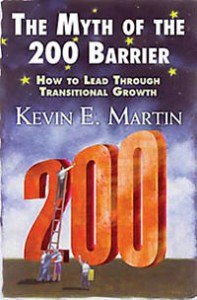Kevin E. Martin is the executive director of Vital Church Ministries, a teaching and consulting outreach of the Cathedral Church of Saint Matthew in Dallas, Texas. His book, The Myth of the 200 Barrier: How to Lead through Transitional Growth, provides insight into the tensions that occur when attempting to grow a small family-size church with an Average Sunday Attendance (ASA) of 150 or less into a larger program-size congregation with an ASA of 225 or more. The book explains why a “transitional church” (with an ASA of 150 to 225) often feels caught between two dynamics — the cultural and denominational pressure to become a larger, more vital church with a variety of programs and needs-based ministries, and its current reality as a smaller, but loving, vital, and faithful family community of 150 or less in worship.
There are differences in pastoral leadership styles, church structures, and congregational expectations for churches above and below the 200 mark. As a congregation moves forward into this “transitional church” phase, new pressures and expectations can cause increased tension in the church and its family system.
Martin discusses a myth, known as the “200 Barrier,” that seems to block a church’s growth. This mythical barrier is the supposed result of a congregation’s willful resistance to change and pastoral misunderstandings about what is needed to help a church of 150 or less become a larger church. There are differences in pastoral leadership styles, church structures, and congregational expectations for churches above and below the 200 mark. As a congregation moves forward into this “transitional church” phase, new pressures and expectations can cause increased tension in the church and its family system. Martin challenges the reader with thought-provoking questions such as: “What is the right size for this church?” “What has made this a successful and growing pastoral church?” “What will I need to transform the present culture of this church to facilitate growth to  a larger size?” and “How will I modify my leadership style and congregational expectations to lead this transitional growth?”
a larger size?” and “How will I modify my leadership style and congregational expectations to lead this transitional growth?”
Martin does not idealize the transitional growth phase. He presents it as a tension-filled period that calls for dedicated congregants and tenacious pastoral leaders. He clearly identifies the stresses and the hard work necessary as a church and its leaders approach the tipping point. He acknowledges that a congregation must break many long-engrained patterns of behavior. However, Martin then focuses on how to embrace these changes. He challenges churches and pastors to step into this transformational journey and remain faithful to their calling to build the Kingdom of God. Martin’s inward-to-outward approach to congregational transition offers church leaders and pastors challenging new ways of thinking about their congregational calling and provides new perspectives to help them step into these uncharted waters. The resulting new growth will keep us and the church in the freshness of Christ’s vision and calling.






